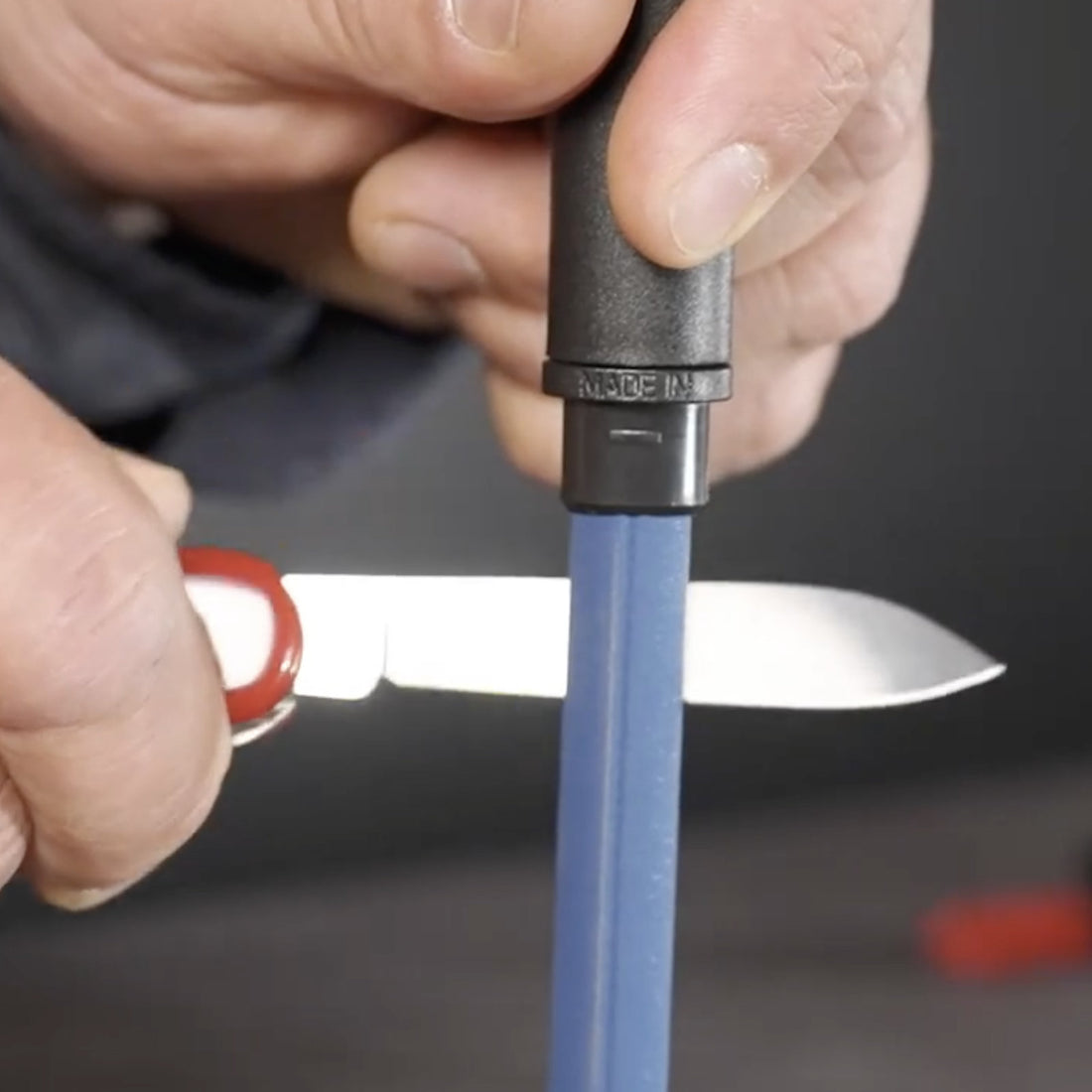Sharpening Your Swiss Army Knife - Tools and Techniques
Though every Victorinox Swiss Army Knife comes razor-sharp from the factory in Switzerland, day-to-day use can wear down the edge of these durable blades. If your Swiss Army Knife is your everyday go-to tool, it may be time to show it a little love.
Please proceed with caution when sharpening any knife blade. Safety tools such as cut-proof gloves are a good option if you are just learning.
This video and the article below walk you through the process of sharpening your pocket knife with several different sharpening tool options, from Victorinox's Pocket Sharpener to a classic whetstone.
No matter which method you choose, your knife is just a few short steps from being as sharp as new.
1. Test the Sharpness of Your Swiss Army Knife Blade
To determine if your blade needs TLC, try the paper test. Take a standard sheet of paper and, starting perpendicular to the top edge, try to draw your blade down through the paper. A sharp blade will produce a smooth, clean cut.
If your blade needs to be sharpened, the cut will be rougher, and the paper may even tear, as shown in the image below.

2. Select Your Sharpener
While you can use a knife sharpener that you would use for kitchen knives, the Victorinox Pocket Knife Sharpener is a great, portable solution for keeping your Swiss Army Knife's blade in factory-new condition.
This handy tool, which is the size of a pen, features both a grindstone, and a ceramic v-sharpener.

Sharpening stones are another option. Victorinox offers a sharpening stone that is the perfect size for a Swiss Army Knife, and comes in a protective leather sheath.
DMT, a brand of sharpeners made in America, also has some portable folding sharpeners well-suited for knives of this size, including the mini.
Explore our complete collection of sharpeners to find the one best for you.
3. Begin Sharpening with a Coarse Grindstone
How to Use the Victorinox Pocket Sharpener to Sharpen Your Blade
To remove larger burrs and nicks from your blade, begin sharpening with the grindstone. Place the grindstone on a table or another secure surface, holding it perpendicularly (if using a tool such as the pocket knife sharpener above). Then, draw the edge of your knife blade along the grindstone at about a 15-20 degree angle, ensuring that you slide the entire length of each side of the blade against the sharpening surface. Alternate sides of the blade to ensure even sharpening and the correct angle.
How to Use a Sharpening Stone to Sharpen Your BladeIf you are using a flat whetstone sharpener such as the Victorinox sharpening stone, first wet the sharpening stone, and then put the stone flat on the table. Next, draw the length of the blade along the sharpening stone at a 15 - 20 degree angle, alternating the two sides of the blade.
If the whetstone is smaller and thinner, the handle of your Swiss Army Knife can be placed flat on the table, with the blade extending out over the edge. Draw the wetted whetstone in a zig-zag pattern over the length of the blade at that same angle of 15 - 20 degrees. After a few passes, turn the knife over to access the second side of the blade, and repeat the process.
How to Use a Diamond Sharpener to Sharpen Your BladeTo use a diamond sharpener, such as those made by DMT, place these flat on the edge of the table, and draw the full length of the blade over the sharpening surface at that 15 - 20 degree angle, alternating sides.
4. Finish with a Fine Grit Sharpener
To complete the process, use a sharpener with a fine grit.
If it is v-sharpener as the one built into the Victorinox Pocket Knife Sharpener, draw your Swiss Army Knife blade through the V several times. The advantage of a v-sharpener is that the angle is pre-set, making it easy to sharpen your Swiss Army Knife blade to an even, ideal angle.
If you are using a fine-grit diamond sharpener or whetstone to finish your sharpening, follow the same steps as you did with the coarse diamond and whetstone sharpeners in step 3 above.
Once you have completed this process, your Swiss Army Knife blade should be in great shape. Wipe off any excess filings or grit, and then try the paper test again. Your blade should slice smoothly through the paper with little effort if it is sufficiently sharpened.
5. Clean and Oil Your Swiss Army Knife
Now that your knife is sharp once again, learn how to clean and lubricate it. >


